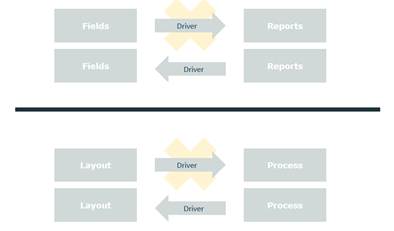Continuing my focus on key organizational readiness topics that help us deliver successful PPM business outcomes, I will discuss the concepts around CA PPM installation models, a hot topic that will also be discussed at CA World 2016. Here, I’ve enlisted the help of CA Services Managing Consultant Paul Obirek, who has 12 years of experience architecting and implementing solutions.
To stay on the topic of “usability,” it’s important to note that the out-of-the-box CA PPM product incorporates best practices and process-centric actions, but since every organization is unique, we align the product so that it can support organizational idiosyncrasies. When designing, I like to think of it this way:

As a best-in-class platform, CA PPM excels at UI-driven configurations; here are a few options to consider. These are the typical CA PPM implementation models:
|
| Common configuration | - Single install
- Same configuration for all
- Easiest to maintain
- Common business process
- Limited organizational scope
- Suited to smaller or homogenous organizations
| - Limited business scalability
- Requires organizational consensus
- Difficult to support multiple methodologies
|
| Multi-partition | - “Core” configuration
- Broader organizational scope
- Better support of multiple methodologies
- Supports divergent requirements
| - Defining a common configuration
- Prioritizing changes
- Change Control
- Increased administration complexity
|
| Multi-instance | - Multiple install
- Different configurations
- Divergent business needs
| - Achieving a common approach
- Consolidating data
- Business processes
|
Deciding which model to use must be given careful consideration, as each model has a different effect on the product’s usability and security for end users, and each model’s operational support and system scalability must be handled differently. Some considerations:
- Common configuration works well in a turnkey model, where an organization leverages common best PPM practices or methodology to drive a structured approach for all activities. This is appropriate for smaller or less mature organizations that don’t have competing demands from different groups using the system. It also works well at highly mature enterprise PMOs that have governance and change control in place. The key here is that all people in a particular role who use the system act in the same way, such as resource managers who need the same views and take the same actions, or project managers who follow the same methodology, no matter which department the resource or project managers are in.
- Multi-partition is suited to groups that support multiple methodologies and have unique system requirements. This increases system complexity and requires prioritizing changes as well as sharing of views.
- Multi-instance is valuable when organizations are massive in size, disparate in structure, and siloed in nature, driving the need for distinct implementation models. This is the “no-share” option, and although it’s possible to roll up data for reporting in an external data warehouse, many data level considerations must be made to consolidate data for cross-instance reporting.
While the information above is important to have at all stages of maturation, many organizations start with common configuration, and as they mature, evolve to multi-partition and/or multi-instance. As demand on the system functions changes, organizations need to re-evaluate the model currently in use and make changes if necessary. To address these changes, a governance and organizational management schema for central control must be established. As Paul recommends to help guarantee success when planning this central control, the following activities need to be performed:
- Define a clear vision
- Recognize organizational differences and challenges across departments
- Don’t boil the ocean when making changes
- Set clear, achievable, and incremental goals
- Set common standards
- Understand your future-state needs
- Employ the GEMO (good enough to move on) data model principle (i.e., don’t go overboard)
- Establish and maintain governance
- Confirm community ownership of backlog
- Clear change control to common standards
- Commit to regular well-documented and well-communicated releases
- Assign ownership of business process change
I would like to give a special shout out to Paul for his insights! As PPM system and process practitioners, we can greatly improve the value of a solution by focusing on these suggestions for helping people use successful adoption strategies.
For readers interested in more detail, check out my Blog Series. I encourage you to participate in the best-in-class site, where we have access to our peers, events and support. You can also reach out to CA Services for individualized business outcome references and analysis. Feel free to post in the comments section of this blog or contact me directly via email and @PPMWarrior.